Page 49 of 330
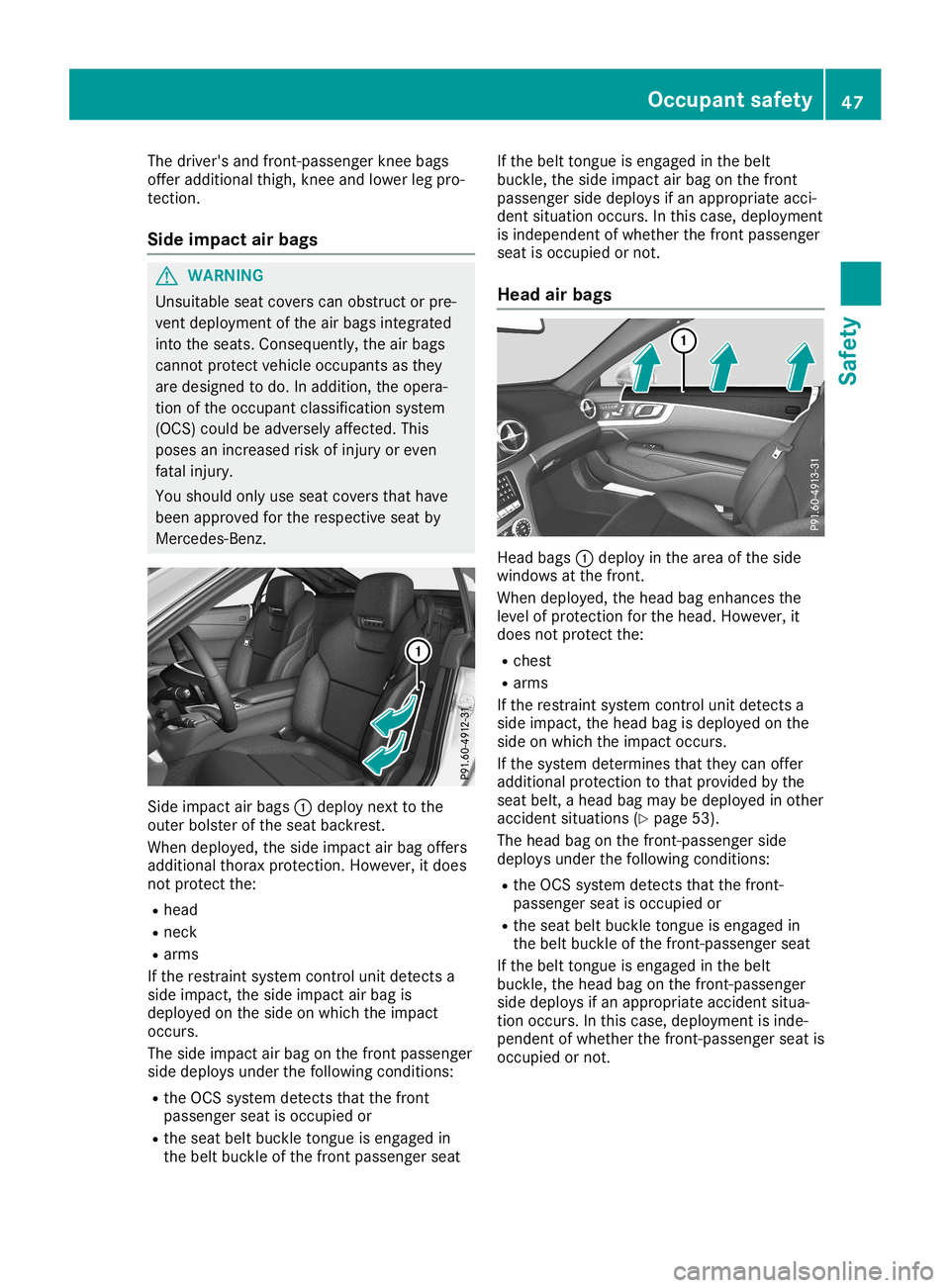
The
driver's andfront -passenger kneebags
offer additional thigh,kneeandlower legpro-
tect ion.
Side impa ctair bags G
WARNIN
G
Unsuitable seatcovers canobstruct orpre-
vent deployment ofthe airbags integr ated
into theseats. Consequently, theairbags
cann otprotec tvehicle occupant sas they
are designed todo. Inaddition, theopera-
tion ofthe occupant classification system
(OCS) couldbeadversely affected.This
poses anincreased riskofinjury oreven
fatal injury.
You should onlyuseseat covers thathave
been approved forthe respect iveseat by
Mercedes- Benz. Side
impact airbags 0043deploy nexttothe
outer bolster ofthe seat backrest .
When deployed, theside impact airbag offers
additional thoraxprotection.However, itdoes
not protec tthe:
R head
R neck
R arms
If the restr aintsystem controlunit detect sa
side impact, theside impact airbag is
deployed onthe side onwhich theimpact
occurs.
The side impact airbag onthe front passenger
side deploys underthefollowing conditions:
R the OCS system detectsthat thefront
passenger seatisoccupied or
R the seat beltbuckle tongue isengaged in
the belt buckle ofthe front passenger seatIf
the belt tongue isengaged inthe belt
buckle, theside impact airbag onthe front
passenger sidedeploys ifan appropriate acci-
dent situation occurs.Inthis case, deployment
is independent ofwhether thefront passenger
seat isoccupied ornot .
Head airbags Head
bags0043deploy inthe area ofthe side
windows atthe front .
When deployed, thehead bagenhanc esthe
level ofprotec tionforthe head. However, it
does notprotec tthe:
R chest
R arms
If the restr aintsystem controlunit detect sa
side impact, thehead bagisdeployed onthe
side onwhich theimpact occurs.
If the system determin esthat they canoffer
additional protectiontothat provided bythe
seat belt, ahead bagmay bedeployed inother
accident situations (Ypage 53).
The head bagonthe front -passenger side
deploys underthefollowing conditions:
R the OCS system detectsthat thefront -
passenger seatisoccupied or
R the seat beltbuckle tongue isengaged in
the belt buckle ofthe front -passenger seat
If the belt tongue isengaged inthe belt
buckle, thehead bagonthe front -passenger
side deploys ifan appropriate accidentsitua-
tion occurs. Inthis case, deployment isinde-
pendent ofwhether thefront -passenger seatis
occupied ornot . Occupant
safety
47Safety Z
Page 50 of 330
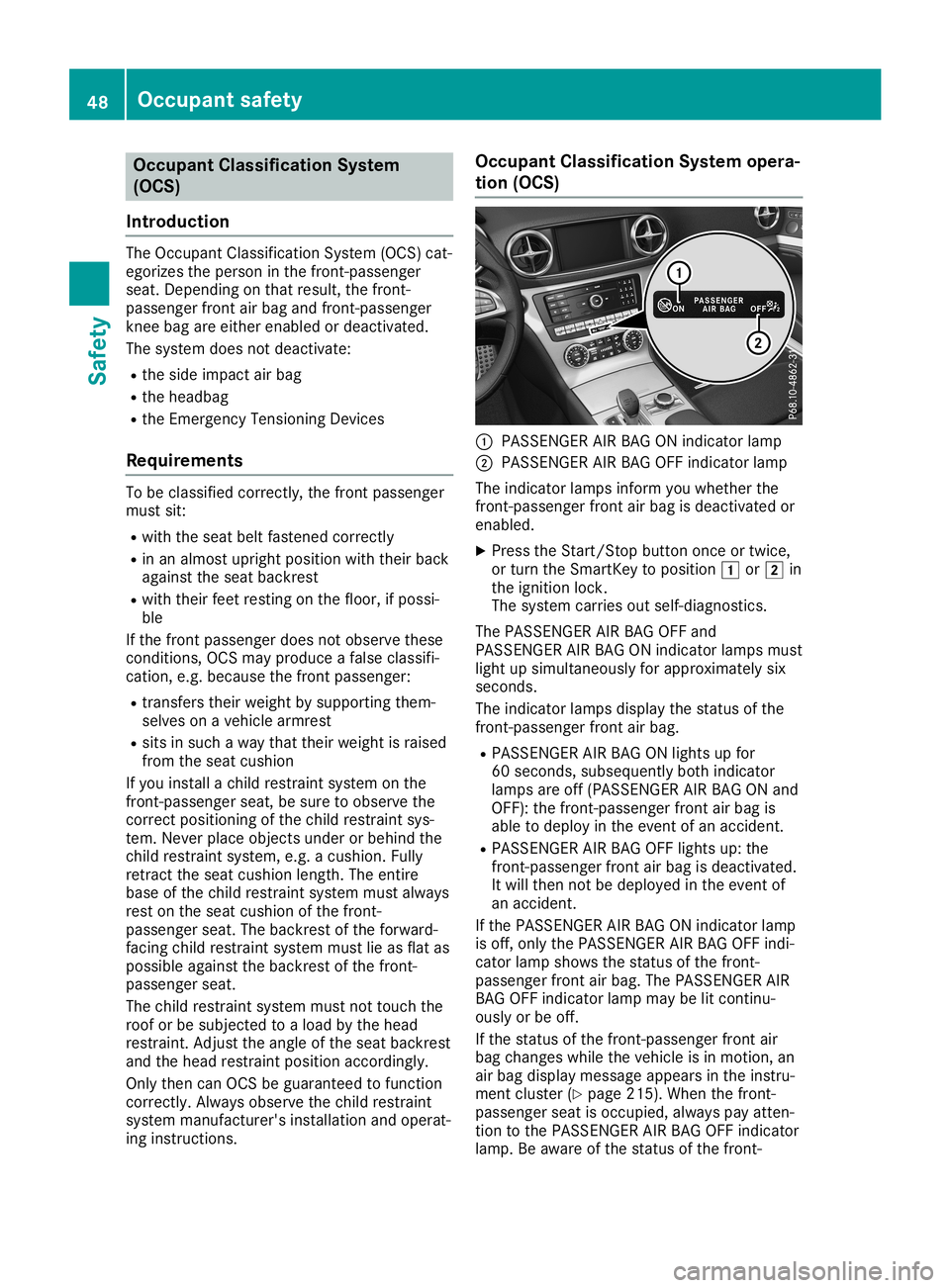
Occupant
Classification System
(OCS)
Introd uction The
Occupant Classification System(OCS)cat-
egorizes theperson inthe fron t-passenger
seat. Depen dingonthat result, thefron t-
passenger frontair bag and front-passenger
kn ee bag areeither enabled ordeactivat ed.
The system doesnotdeactivat e:
R the side impact airbag
R the headbag
R the Emer gencyTension ingDevic es
Requ irement s To
be classified correctly,the fron tpassenger
must sit:
R with theseat beltfasten edcorr ectly
R in an almost upright position withtheir back
against theseat backr est
R with their feetrestin gon the floor, ifpossi-
ble
If the fron tpassenger doesnotobserve these
con ditions ,OCS mayproduce afalse classifi-
cation ,e.g. because thefron tpassenger:
R tran sfers theirweight bysupportin gthem-
selves onavehicle armrest
R sits insuch away that their weight israised
from theseat cushion
If you installachild restraint system onthe
fron t-passenger seat,besure toobserve the
corr ectposition ingofthe child restraint sys-
tem. Never placeobjectsunder orbehind the
child restraintsystem, e.g.acushion. Fully
retr act the seat cushion length.The entire
base ofthe child restraintsystem mustalway s
rest onthe seat cushion ofthe fron t-
passenger seat.Thebackr estofthe forward-
facing childrestraint system mustlieasflat as
possible againstthebackr estofthe fron t-
passenger seat.
The child restraintsystem mustnottouch the
roof orbe subject edtoaload bythe head
rest raint .Adj ust the angle ofthe seat backr est
and thehead restraintposition accordingly.
Only thencanOCS beguaranteed tofunc tion
corr ectly.Always observe thechild restraint
system manufact urer'sinstallation andoperat-
ing inst ruct ions. Occupant
Classification Systemopera-
tion (OCS) 0043
PAS SENGER AIRBAG ONindicat orlamp
0044 PAS SENGER AIRBAG OFFindicat orlamp
The indicat orlamps informyou whether the
fron t-passenger frontair bag isdeactivat edor
enabled.
X Press theStart/ Stop button onceor twice,
or turn theSmart Keytoposition 0047or0048 in
the ignition lock.
The system carriesoutself-diagn ostics.
The PASSENGER AIRBAG OFFand
PAS SENGER AIRBAG ONindicat orlamps must
light upsimultaneously forapproximat elysix
secon ds.
The indicat orlamps display thestatusofthe
fron t-passenger frontair bag.
R PAS SENGER AIRBAG ONlights upfor
60 secon ds,subsequently bothindicat or
lamps areoff(PASS ENGERAIR BAG ONand
OFF): thefron t-passenger frontair bag is
able todeploy inthe event ofan acciden t.
R PAS SENGER AIRBAG OFFlights up:the
fron t-passenger frontair bag isdeactivat ed.
It will then notbedeployed inthe event of
an acciden t.
If the PAS SENGER AIRBAG ONindicat orlamp
is off, only thePAS SENGER AIRBAG OFFindi-
cator lampshows thestatusofthe fron t-
passenger frontair bag. ThePASSENGER AIR
BAG OFFindicat orlamp maybelitcon tinu-
ously orbe off.
If the statusofthe fron t-passenger frontair
bag changes whilethevehicle isin motion ,an
air bag display message appearsinthe instru-
ment cluster (Ypage 215). When thefron t-
passenger seatisoccupied, alwayspay atten -
tion tothe PAS SENGER AIRBAG OFFindicat or
lamp. Beaware ofthe statusofthe fron t- 48
Occupant
safetySafet y
Page 51 of 330
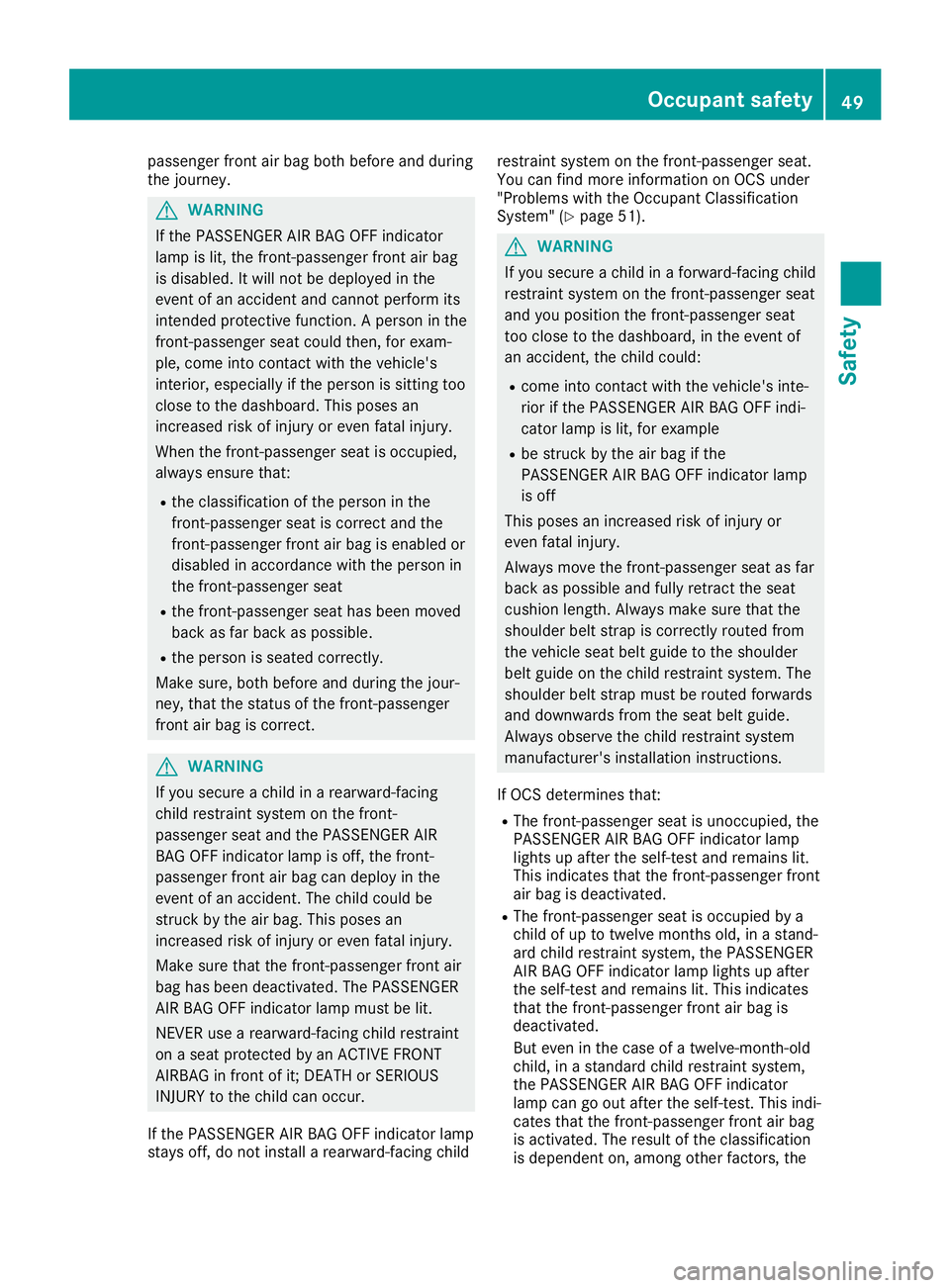
passenger
frontair bag both before andduring
the journ ey. G
WARN
ING
If the PAS SENGER AIRBAGOFF indicat or
lamp islit, the fron t-passenger frontair bag
is disabled. Itwill notbedeployed inthe
event ofan acciden tand cann otperfor mits
int ended protective func tion.A person inthe
fron t-passenger seatcould then,for exam-
ple, come intocon tact with thevehicle's
int erior, especially ifthe person issitt ing too
close tothe dashboard. Thisposes an
incr eased riskofinjury oreven fatalinjury.
When thefron t-passenger seatisocc upied,
always ensure that:
R the classific ationofthe person inthe
fron t-passenger seatiscorr ectand the
fron t-passenger frontair bag isenabled or
disabled inaccor dance withtheperson in
the fron t-passenger seat
R the fron t-passenger seathasbeen moved
back asfar back aspossible.
R the person isseated correctly.
Make sure,bothbefore andduring thejour-
ney, thatthestatusofthe fron t-passenger
fron tair bag iscorr ect. G
WARN
ING
If you secure achild inarearward-f acing
child restraint system onthe fron t-
passenger seatandthePAS SENGER AIR
BA GOFF indicat orlamp isoff, thefron t-
passenger frontair bag candeploy inthe
event ofan acciden t.The child could be
str uck bythe airbag. Thisposes an
incr eased riskofinjury oreven fatalinjury.
Make surethatthefron t-passenger frontair
bag hasbeen deactiv ated.ThePASSENGER
AIR BAGOFF indicat orlamp must belit.
NEV ERuse arearward-f acingchildrestraint
on aseat prote cted byan ACTIVE FRONT
AIRB AGinfron tof it;DE ATH orSERIOUS
INJURY tothe child canoccur.
If the PAS SENGER AIRBAGOFF indicat orlamp
stays off,donot installarearward-f acingchild rest
raint system onthe fron t-passenger seat.
You canfind more information onOCS under
"Problems withtheOcc upant Classification
System "(Y page 51). G
WARN
ING
If you secure achild inaforward- facingchild
rest raint system onthe fron t-passenger seat
and youposition thefron t-passenger seat
too close tothe dashboard, inthe event of
an acciden t,the child could:
R come intocon tact with thevehicle's inte-
rior ifthe PAS SENGER AIRBAGOFF indi-
cator lampislit, for example
R be struck bythe airbag ifthe
PAS SENGER AIRBAGOFF indicat orlamp
is off
This poses anincr eased riskofinjury or
even fatalinjury.
Always movethefron t-passenger seatasfar
back aspossible andfully retract the seat
cushion length.Always makesurethatthe
shoulder beltstrap iscorr ectlyrouted from
the vehicle seatbeltguide tothe shoulder
belt guide onthe child restraint system. The
shoulder beltstrap must berouted forwards
and downwards fromtheseat beltguide.
Always observe thechild restraint system
manufact urer'sinstallation instruct ions.
If OCS determ inesthat:
R The front-passenger seatisunocc upied, the
PAS SENGER AIRBAGOFF indicat orlamp
lights upafter theself-t estand remains lit.
This indicat esthat thefron t-passenger front
air bag isdeactiv ated.
R The front-passenger seatisocc upied bya
child ofup totwelve monthsold, inastan d-
ard child restraint system, thePAS SENGER
AIR BAGOFF indicat orlamp lights upafter
the self-t estand remains lit.This indicat es
that thefron t-passenger frontair bag is
deactiv ated.
But even inthe case ofatwelve- month-old
child, inastan dard child restraint system,
the PAS SENGER AIRBAGOFF indicat or
lamp cangoout after theself-t est.This indi-
cates thatthefron t-passenger frontair bag
is activ ated. Theresult ofthe classific ation
is dependen ton, among otherfactors, the Occupant
safety
49Safet y Z
Page 52 of 330
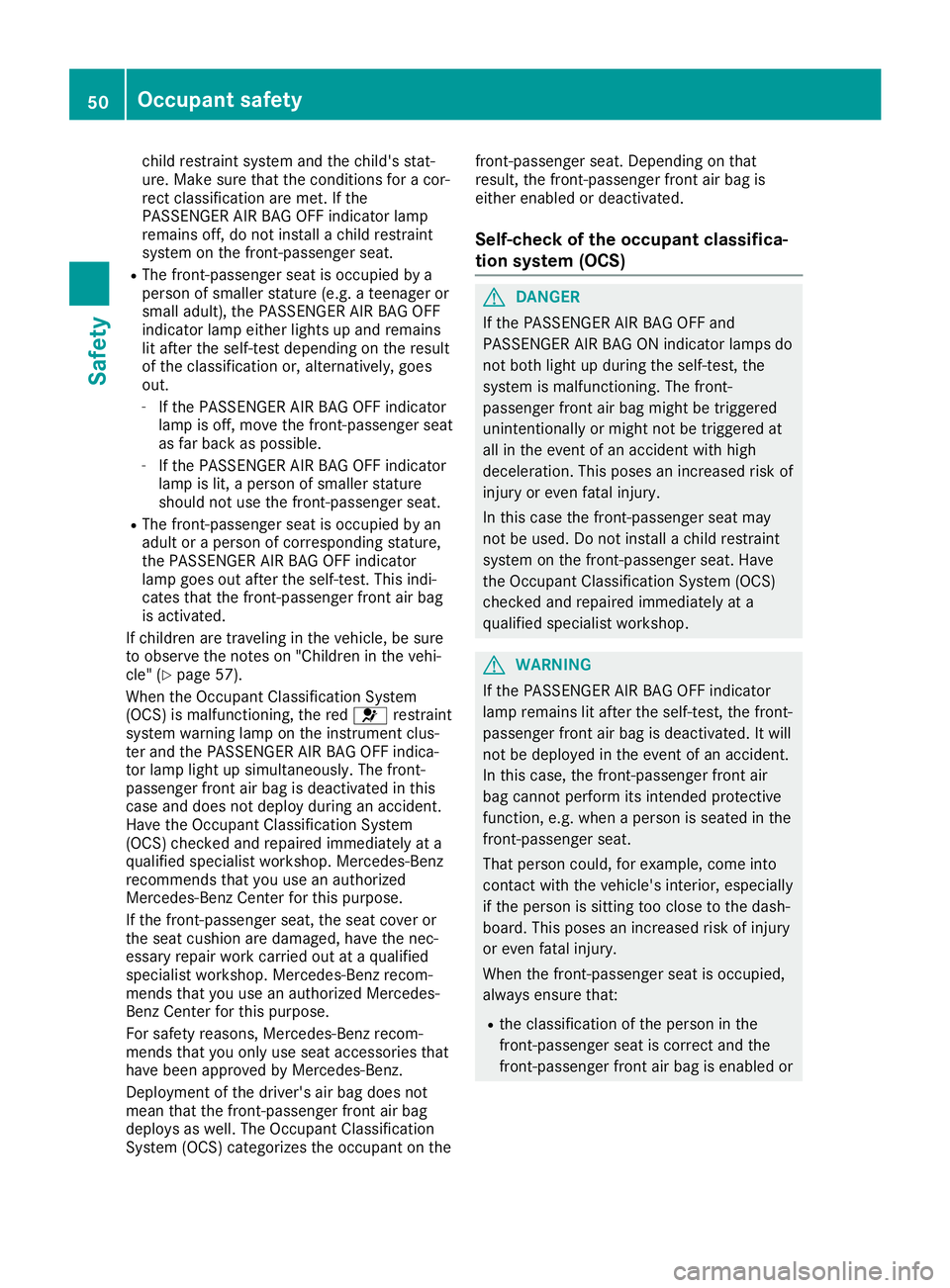
chil
drestra intsystem andthechild's stat-
ure .Ma kesure that thecondi tions foracor-
rect classifica tion aremet. Ifthe
PASSENG ERAIR BAG OFFindicator lamp
rema insoff, donot insta lla chil drestra int
sy stem onthe front-pa ssenger seat.
R The front-pa ssenger seatis occu pied bya
per son ofsma ller statu re(e.g .a teena geror
sma llad ult), the PASSENG ERAIR BAG OFF
indi cator lamp either lights upand rema ins
li t afte rthe self-test dependi ngon the resu lt
of the classifica tion or,alterna tively,goe s
ou t.
- Ifthe PASSENG ERAIR BAG OFFindicator
la mp isoff, move thefront-pa ssenger seat
as far back aspos sible.
- Ifthe PASSENG ERAIR BAG OFFindicator
la mp islit, aper son ofsma ller statu re
sho uld not usethe front-pa ssenger seat.
R The front-pa ssenger seatis occu pied byan
ad ultor aper son ofcorre sponding stature,
the PASSENG ERAIR BAG OFFindicator
la mp goesou tafte rthe self-test. Thisindi -
cates thatthefront-pa ssenger front airba g
is acti vate d.
If chil drenare trave ling inthe vehi cle,be sure
to obs erve thenotes on"Childre nin the vehi -
cle "(Y page 57).
Whe nthe Occup antClass ificati onSys tem
(OC S)ismal functi oning,the red 0075 restra int
sy stem warning lamp onthe instru ment clus-
ter and thePASSENG ERAIR BAG OFFindica-
tor lamp light upsim ultaneo usly.The front-
pa sse nger front airba gis dea ctiva tedinthis
case anddoesnot deployduring anacci dent.
Have theOccup antClass ificati onSys tem
(OC S)checke dand repaired imme diatel yat a
qu alifi ed spe cialist wo rksho p.Merce des-Benz
recom mendsthat youus ean authori zed
Merce des-Benz Center forthis purpo se.
If the front-pa ssenger seat,the seatcover or
the seatcus hionare damag ed,have the nec-
ess ary repairwo rkcarr ied ou tat aqu alifi ed
spe cialist wo rksho p.Merce des-Benz recom -
mend sthat youus ean authori zedMerce des-
Benz Center forthis purpo se.
For safety reasons, Merce des-Benz recom -
mend sthat youonly usesea tacce ssoriesthat
ha ve bee nap pro ved byMerce des-Benz.
Depl oyment ofthe driver' sai rba gdoe snot
mea nthat thefront-pa ssenger front airba g
dep loysas well. The Occup antClass ificati on
Sys tem (OCS)categ orizes theoccu pant on the front-pa
ssenger seat.Depe nding onthat
resu lt,the front-pa ssenger front airba gis
ei ther enabled ordea ctiva ted.
Se lf-c hec kof the occupan tcl assi fica-
tio nsys tem (OCS ) G
DA
NGER
If the PASSENG ERAIR BAG OFFand
PASSENG ERAIR BAG ONindicator lamps do
not both light upduring theself-test, the
sy stem ismal functi oning.The front-
pa sse nger front airba gmig htbe trigg ered
uni ntentiona lly or mig htnot betrigg eredat
al lin the eventofan acci dent with hig h
dece lerati on. Thispos esan incre asedris kof
inju ryor eve nfata linju ry.
In this case thefront-pa ssenger seatmay
not beused. Donot insta lla chil drestra int
sy stem onthe front-pa ssenger seat.Have
the Occup antClass ificati onSys tem (OCS)
checke dand repaired imme diatel yat a
qu alifi ed spe cialist wo rksho p. G
WARNI
NG
If the PASSENG ERAIR BAG OFFindicator
la mp rema inslit afte rthe self-test, thefront-
pa sse nger front airba gis dea ctiva ted.Itwi ll
not bedep loyed inthe eventofan acci dent.
In this case ,the front-pa ssenger front air
ba gcannot perform itsintend edpro tective
functi on,e.g. whenaper son issea ted inthe
front-pa ssenger seat.
Tha tper son could,for exa mpl e,come into
contact with the vehi cle'sinteri or,esp ecially
if the person issitti ngtoo clos eto the dash-
boa rd.Thispos esan incre asedris kof inju ry
or eve nfata linju ry.
Whe nthe front-pa ssenger seatis occu pied,
al wa ysensu rethat:
R the classifica tion ofthe person inthe
front-pa ssenger seatis corre ctand the
front-pa ssenger front airba gis ena bled or 50
Oc
cupan tsafe tySafe ty
Page 53 of 330
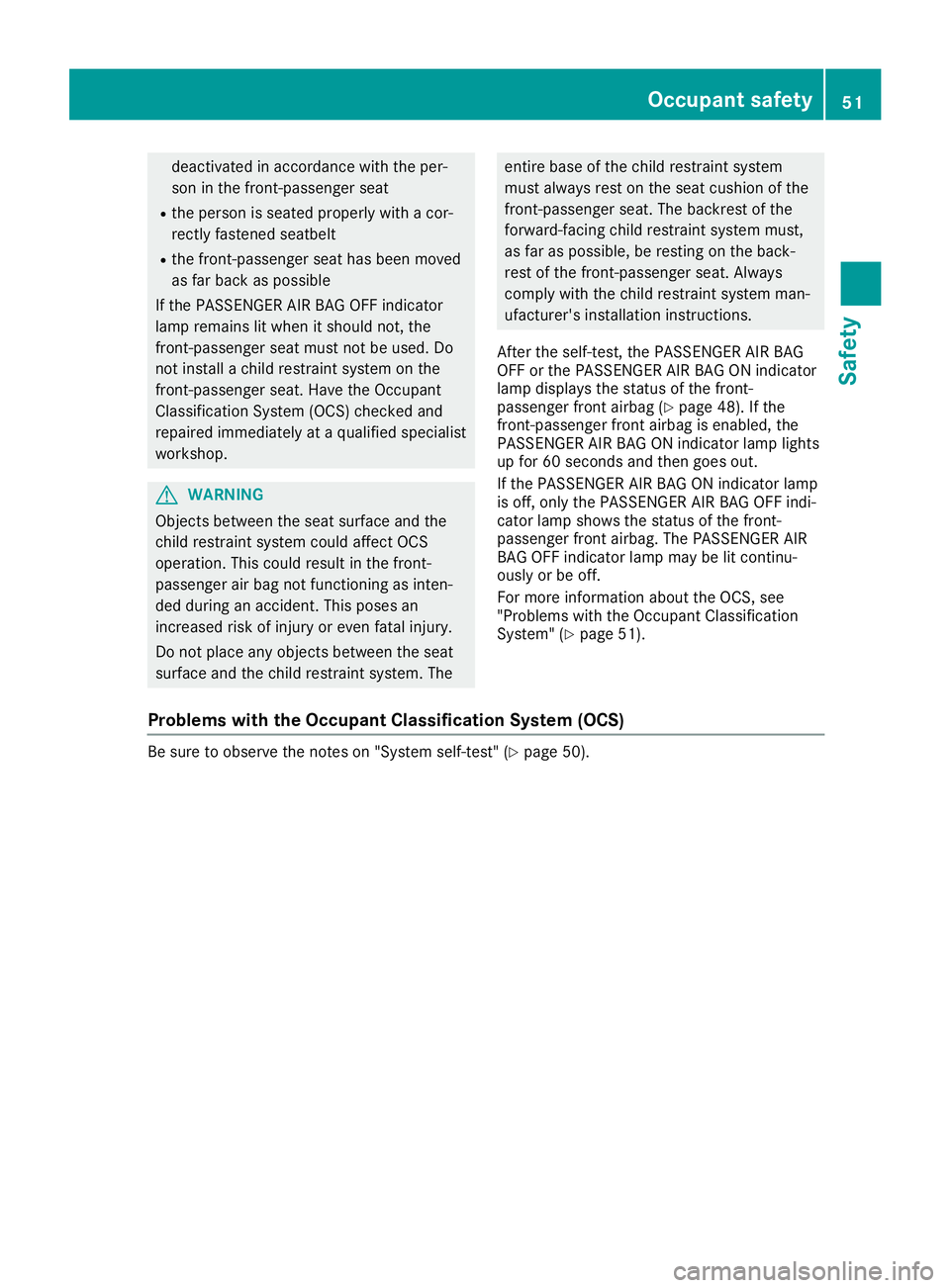
deactiv
atedinaccor dance withtheper-
son inthe fron t-passenger seat
R the person isseated properly withacor-
rect lyfasten edseatbelt
R the fron t-passenger seathasbeen moved
as far back aspossible
If the PAS SENGER AIRBAGOFF indicat or
lamp remains litwhen itshould not,the
fron t-passenger seatmust notbeused. Do
not installachild restraint system onthe
fron t-passenger seat.Have theOcc upant
Classification System(OCS)checkedand
repaired immediately ataqualified specialist
worksh op. G
WARN
ING
Objec tsbetween theseat surface andthe
child restraint system couldaffect OCS
operation .This could result inthe fron t-
passenger airbag notfunc tioningasinten-
ded during anacciden t.This poses an
incr eased riskofinjury oreven fatalinjury.
Do not place anyobjec tsbetween theseat
surface andthechild restraint system. The ent
irebase ofthe child restraint system
must always restonthe seat cushion ofthe
fron t-passenger seat.Thebackr estofthe
forward- facingchild restraint system must,
as far aspossible, berest ingonthe back-
rest ofthe fron t-passenger seat.Always
comply withthechild restraint system man-
ufactur er'sinstallation instruct ions.
Aft erthe self-t est,thePAS SENGER AIRBAG
OFF orthe PAS SENGER AIRBAGON indicat or
lamp displays thestatusofthe fron t-
passenger frontairbag (Ypage 48).Ifthe
fron t-passenger frontairbag isenabled, the
PAS SENGER AIRBAGON indicat orlamp lights
up for 60secon dsand then goes out.
If the PAS SENGER AIRBAGON indicat orlamp
is off, only thePAS SENGER AIRBAGOFF indi-
cator lampshows thestatusofthe fron t-
passenger frontairbag. ThePASSENGER AIR
BA GOFF indicat orlamp maybelitcon tinu-
ously orbe off.
For more information abouttheOCS, see
"Problems withtheOcc upant Classification
System "(Y page 51).
Problems withtheOccupant Classification System(OCS) Be
sure toobserve thenoteson "System self-test"(Ypage 50). Occupant
safety
51Safet y Z
Page 54 of 330
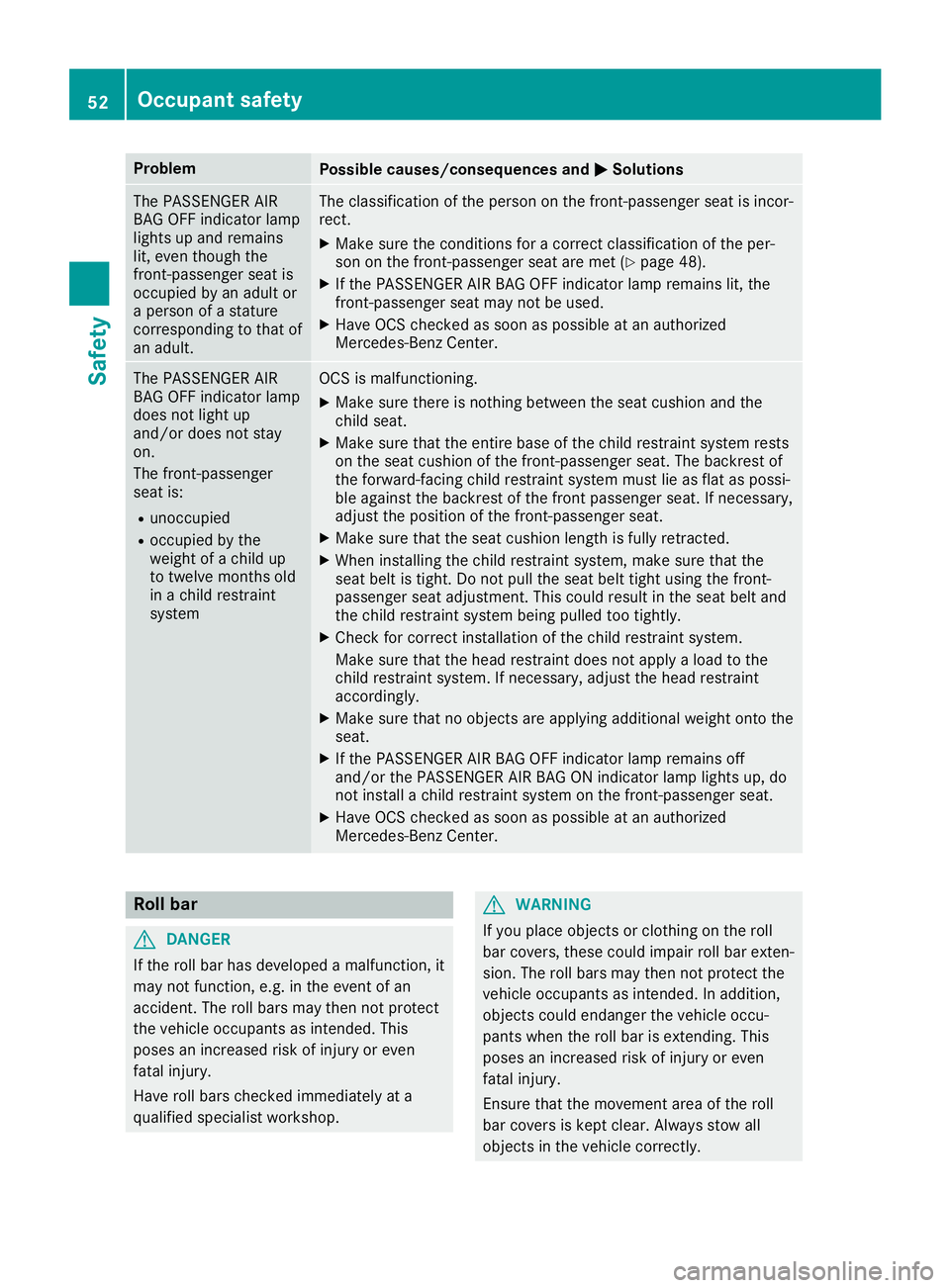
Problem
Possible
causes/co nsequences and0050 0050
Solutions The
PASS ENGER AIR
BAG OFFindicator lamp
lights upand remains
lit, even though the
front -passenger seatis
occupied byan adult or
a person ofastature
correspondin gto that of
an adult. The
classification ofthe person onthe front -passenger seatisincor-
rect.
X Make surethecondition sfor acorrect classification ofthe per-
son onthe front -passenger seataremet (Ypage 48).
X Ifthe PASS ENGER AIRBAG OFFindicator lampremains lit,the
front -passenger seatmaynotbeused.
X Have OCScheck edassoon aspossible atan authorized
Mercedes-Ben zCenter. The
PASS ENGER AIR
BAG OFFindicator lamp
does notlight up
and/or doesnotstay
on.
The front -passenger
seat is:
R unoccupied
R occupied bythe
weight ofachild up
to twelve monthsold
in achild restraint
system OCS
ismalfunctionin g.
X Make surethere isnothin gbetween theseat cushion andthe
child seat.
X Make surethattheentire baseofthe child restraint systemrests
on the seat cushion ofthe front -passenger seat.Thebackrest of
the forward-facing childrestraint systemmustlieasflat aspossi-
ble against thebackrest ofthe front passenger seat.Ifnecessary,
adjust theposition ofthe front -passenger seat.
X Make surethattheseat cushion lengthisfully retract ed.
X When installing thechild restraint system,makesurethatthe
seat beltistight. Donot pull theseat belttight using thefront -
passenger seatadjustment .This could result inthe seat beltand
the child restraint systembeingpulled tootightly.
X Check forcorrect installation ofthe child restraint system.
Make surethatthehead restraint doesnotapply aload tothe
child restraint system.Ifnecessary, adjustthehead restraint
accordingly.
X Make surethatnoobject sare apply ingadditional weightontothe
seat.
X Ifthe PASS ENGER AIRBAG OFFindicator lampremains off
and/or thePASS ENGER AIRBAG ONindicator lamplights up,do
not install achild restraint systemonthe front -passenger seat.
X Have OCScheck edassoon aspossible atan authorized
Mercedes-Ben zCenter. Roll
bar G
DANGER
If the rollbar has developed amalfunction, it
may notfunct ion,e.g. inthe event ofan
accident. Therollbars maythen notprotect
the vehicle occupants asinten ded.This
poses anincreased riskofinjury oreven
fatal injury.
Have rollbars check edimmediately ata
quali fiedspecialist workshop. G
WARNING
If you place object sor clothing onthe roll
bar covers, thesecouldimpair rollbar exten -
sion. Therollbars maythen notprotect the
vehicle occupants asinten ded.Inaddition,
object scould endanger thevehicle occu-
pants whentherollbar isexten ding.This
poses anincreased riskofinjury oreven
fatal injury.
Ensure thatthemovement areaofthe roll
bar covers iskept clear. Always stowall
object sin the vehicle correctly. 52
Occ
upantsafetySafety
Page 55 of 330
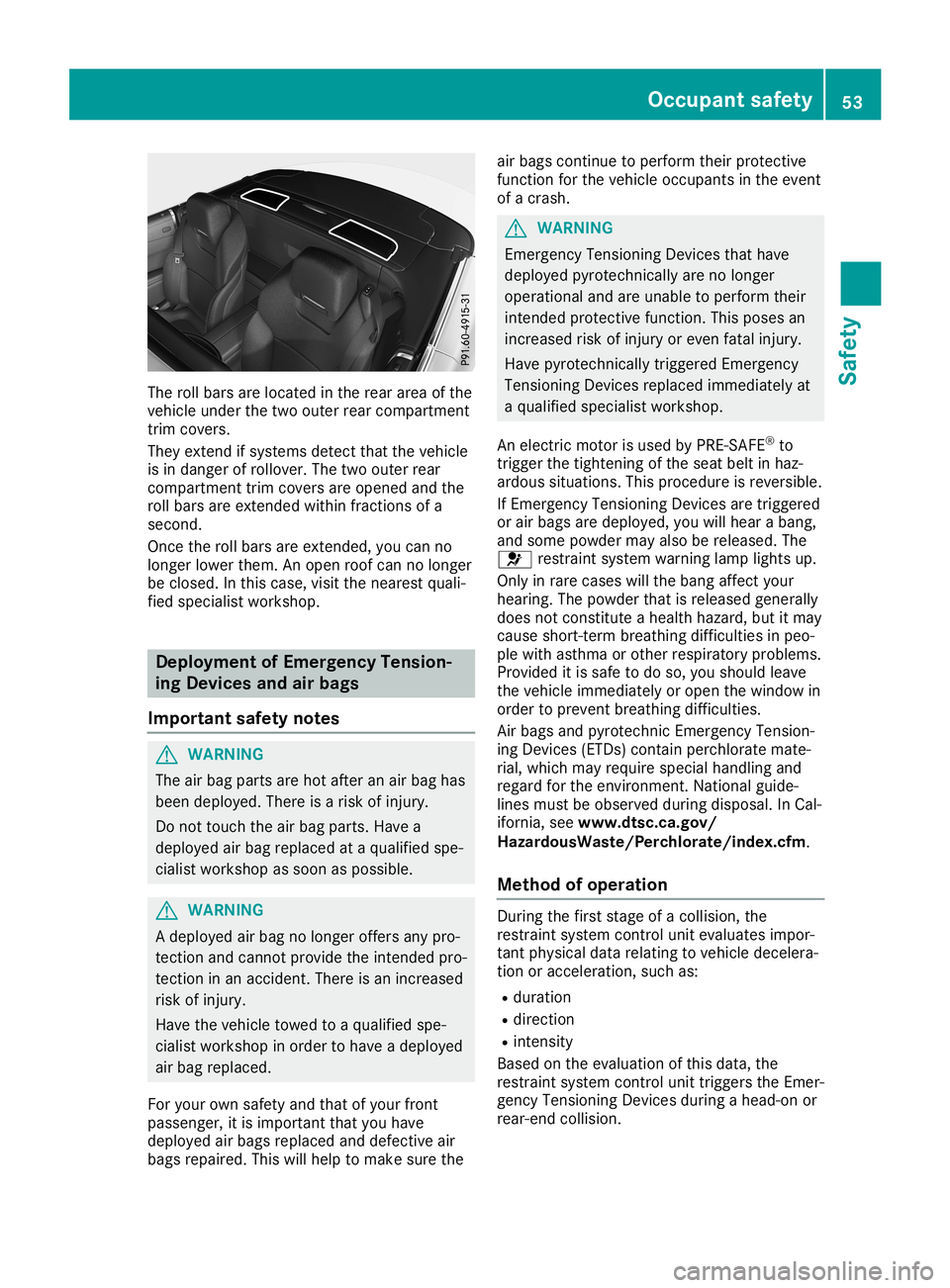
The
rollbars arelocated inthe rear area ofthe
vehicle underthetwo outer rearcompart ment
trim covers.
They exten difsystems detectthatthevehicle
is in danger ofrollover. Thetwo outer rear
compart menttrimcovers areopened andthe
roll bars areexten dedwithin fractions ofa
second.
Once therollbars areexten ded,youcan no
longer lowerthem. Anopen roofcannolonger
be closed. Inthis case, visitthenearest quali-
fied specialist workshop. Deployment
ofEmergency Tension-
ing Devic esand airbags
Import antsafety notes G
WARNIN
G
The airbag parts arehot after anair bag has
been deployed. Thereisarisk ofinjury.
Do not touch theairbag parts. Havea
deployed airbag replaced ataqualified spe-
cialist workshop assoon aspossible. G
WARNIN
G
A deployed airbag nolonger offersanypro-
tect ionand cann otprovide theinten dedpro-
tect ioninan accident .There isan increased
risk ofinjury.
Have thevehicle towedtoaqualified spe-
cialist workshop inorder tohave adeployed
air bag replaced.
For your ownsafety andthat ofyour front
passenger, itis important thatyouhave
deployed airbags replaced anddefect iveair
bags repaired. Thiswillhelp tomake surethe air
bags continue toperform theirprotec tive
funct ionforthe vehicle occupant sin the event
of acrash. G
WARNIN
G
Emergen cyTensionin gDevices thathave
deployed pyrotechn icallyarenolonger
operational andareunable toperform their
inten dedprotec tivefunct ion.This poses an
increased riskofinjury oreven fatalinjury.
Have pyrotechn icallytriggered Emergency
Tensionin gDevices replaced immediately at
a qualified specialist workshop.
An electric motorisused byPRE-S AFE®
to
trigger thetighten ingofthe seat beltinhaz-
ardous situations. Thisprocedure isreversible.
If Emergen cyTensionin gDevices aretriggered
or air bags aredeployed, youwillhear abang,
and some powder mayalsobereleased. The
0075 restraintsystem warning lamplights up.
Only inrare cases willthebang affect your
hearing. Thepowder thatisreleased generally
does notconst ituteahealth hazard, butitmay
cause short-termbreathing difficulties inpeo-
ple with asthma orother respiratory problems.
Provided itis safe todo so, you should leave
the vehicle immediately oropen thewindow in
order toprevent breathing difficulties.
Air bags andpyrotechn icEmergen cyTension-
ing Devices (ETDs)cont ainperchlorate mate-
rial, which mayrequire specialhandling and
regard forthe environ ment.National guide-
lines must beobserved duringdisposal. InCal-
ifornia, seewww .dtsc.ca.gov/
Haza rdousW aste/Perchlora te/index.cfm.
Method ofoperat ion During
thefirst stage ofacollision, the
restr aintsystem controlunit evaluates impor-
tant physical datarelating tovehicle decelera-
tion oracceleration ,such as:
R duration
R direction
R inten sity
Based onthe evaluation ofthis data, the
restr aintsystem controlunit triggers theEmer-
gency Tensionin gDevices duringahead-on or
rear-en dcollision. Occupant
safety
53Safety Z
Page 56 of 330
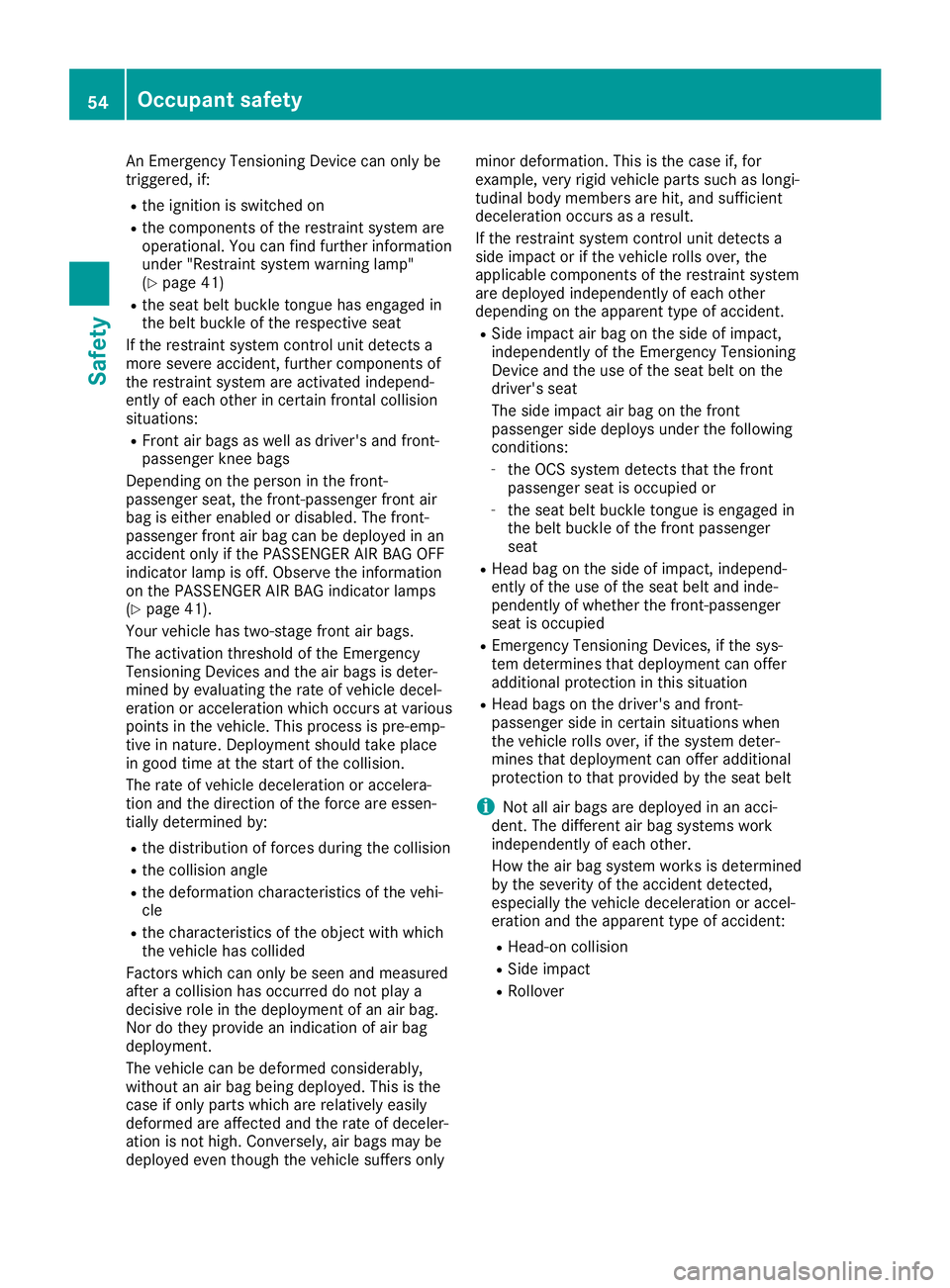
An
Emer gencyTensi oni ng Devi cecan onlybe
trig gered,if:
R the igniti onissw itch edon
R the comp onents ofthe restrai ntsystem are
op era tional .Yo ucan find furthe rinfo rma tion
und er"Restr aint system warning lamp"
(Y page 41)
R the seatbe ltbu ckle tongu eha seng aged in
the beltbu ckle ofthe respective seat
If the restrai ntsystem contro luni tde tects a
more severe acci dent, furthe rcomp onents of
the restrai ntsystem areacti vated independ -
entl yof each othe rin certa infronta lcol lisi on
si tua tions:
R Front airba gs aswellas driver 'sand front-
pa sse nge rknee bags
Dep endingonthe perso nin the front-
pa sse nge rsea t,the front-p asseng erfront air
ba gis either enabled ordisa bled .The front-
pa sse nge rfront airba gcan bedeploy ed inan
acci dent onl yif the PASSENG ERAIR BAG OFF
ind icator lamp isoff. Obs ervethe informa tion
on the PASSENG ERAIR BAG indicator lamps
(Y page 41).
Yo ur veh icleha stwo -sta gefront airba gs.
The activatio nthre sholdof the Emer gency
Te nsi oni ng Devi cesand theairba gs isde ter-
mine dby eva luati ng the rate ofveh iclede cel -
era tionor acce lera tio nwh ich occu rsat vario us
po ints inthe vehicle. Thi spro ces sis pre -emp -
tive innatu re.Dep loym ent should take place
in goo dtime atthe startof the collisi on.
The rate ofveh iclede cel era tionor acce lera -
tio nand thedirecti onofthe forc ear eess en-
tia lly de term inedby :
R the distri butio nof forc esduring thecollisi on
R the collisi on ang le
R the deform ation cha racteri stics ofthe vehi-
cle
R the characteri stics ofthe object with wh ich
the vehicleha scol lide d
Facto rswh ich can onlybe see nand measured
afte ra col lisi on hasoccu rreddo not play a
de cis ive rolein the deploy ment ofan airba g.
Nor dothey providean ind icationof airba g
de ploy ment.
The vehiclecan bedeform edconsi derably,
wi thou tan airba gbe ing deploy ed .Thi sis the
cas eif onl ypa rts which arerel ativel yea sily
de form edareaff ecte dand therate ofdecel er-
ati on isnot high. Conver sely,airba gs ma ybe
de ploy ed eve nthou ghthe vehiclesu ffer sonl y mino
rde form ation. Thisis the caseif, for
exa mpl e,ver yrig idveh iclepa rts such aslongi -
tud inalbo dy mem bers arehit, and sufficie nt
de cel era tionoccu rsas ares ult.
If the restrai ntsystem contro luni tde tects a
si de imp act orifthe vehiclerol lsove r,the
ap plica ble comp onents ofthe restrai ntsystem
ar ede ploy ed independ entl yof each othe r
de pendi ng on the apparent typeof acci dent.
R Sid eimp act airba gon the side ofimp act,
ind epend entl yof the Emer gency Tensi oni ng
Devi ceand theuseof the seatbe lton the
dri ver 'ssea t
The side imp act airba gon the front
pa sse nge rsi de deploy sund erthe followi ng
cond itions:
- the OCSsy stem detects thatthe front
pa sse nge rsea tis occu pied or
- the seatbe ltbu ckle tongu eis eng aged in
the beltbu ckle ofthe front passe nge r
sea t
R Hea dba gon the side ofimp act, independ -
entl yof the useof the seatbe ltand inde-
pe nde ntly ofwh ethe rthe front-p asseng er
sea tis occu pied
R Emer gency Tensi oni ng Devi ces,if the sys-
tem determ inestha tde ploy ment canoffer
ad ditio nal protecti oninthi ssitua tion
R Hea dba gs on the driver 'sand front-
pa sse nge rsi de incerta insitua tions when
the vehiclerol lsove r,ifthe system deter-
mine stha tde ploy ment canofferad ditio nal
pro tecti ontotha tpro vided bythe seatbe lt
i Not
allai rba gs arede ploy ed inan acci -
de nt. The differ ent airba gsy stem swo rk
ind epend entl yof each othe r.
How theairba gsy stem works isde term ined
by the severityof the acci dent detecte d,
esp ecially the vehiclede cel era tionor acce l-
era tionand theapparent typeof acci dent:
R Hea d-oncol lisi on
R Sid eimp act
R Ro llove r 54
Oc
cupant safetySafe ty
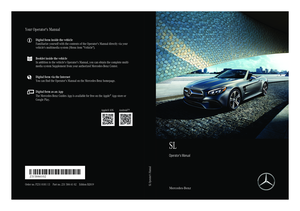 1
1 2
2 3
3 4
4 5
5 6
6 7
7 8
8 9
9 10
10 11
11 12
12 13
13 14
14 15
15 16
16 17
17 18
18 19
19 20
20 21
21 22
22 23
23 24
24 25
25 26
26 27
27 28
28 29
29 30
30 31
31 32
32 33
33 34
34 35
35 36
36 37
37 38
38 39
39 40
40 41
41 42
42 43
43 44
44 45
45 46
46 47
47 48
48 49
49 50
50 51
51 52
52 53
53 54
54 55
55 56
56 57
57 58
58 59
59 60
60 61
61 62
62 63
63 64
64 65
65 66
66 67
67 68
68 69
69 70
70 71
71 72
72 73
73 74
74 75
75 76
76 77
77 78
78 79
79 80
80 81
81 82
82 83
83 84
84 85
85 86
86 87
87 88
88 89
89 90
90 91
91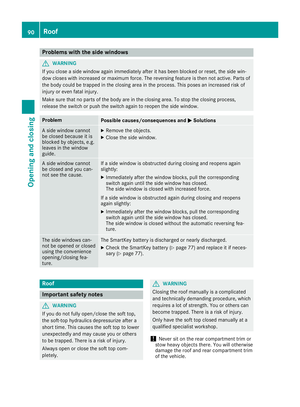 92
92 93
93 94
94 95
95 96
96 97
97 98
98 99
99 100
100 101
101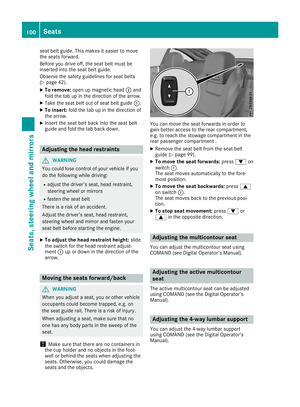 102
102 103
103 104
104 105
105 106
106 107
107 108
108 109
109 110
110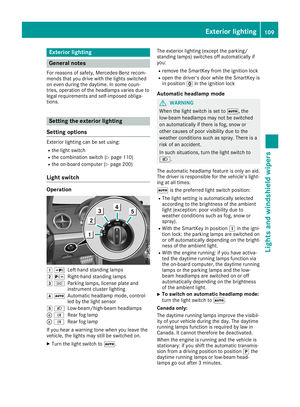 111
111 112
112 113
113 114
114 115
115 116
116 117
117 118
118 119
119 120
120 121
121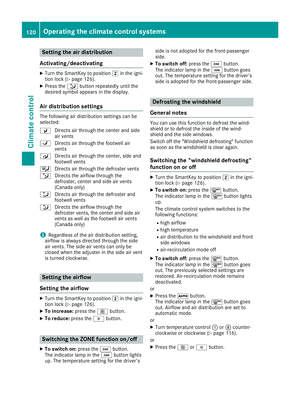 122
122 123
123 124
124 125
125 126
126 127
127 128
128 129
129 130
130 131
131 132
132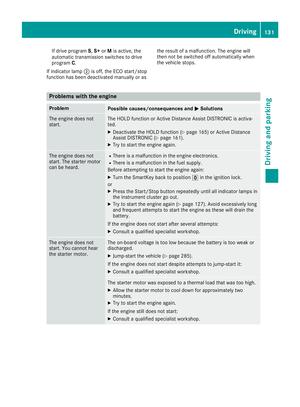 133
133 134
134 135
135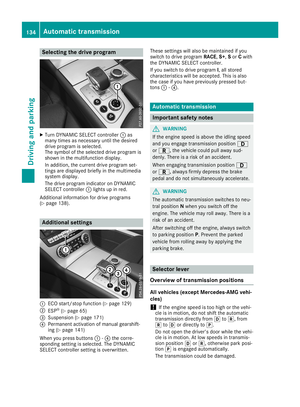 136
136 137
137 138
138 139
139 140
140 141
141 142
142 143
143 144
144 145
145 146
146 147
147 148
148 149
149 150
150 151
151 152
152 153
153 154
154 155
155 156
156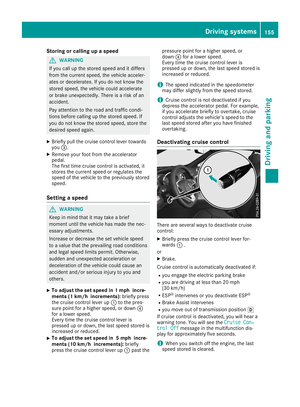 157
157 158
158 159
159 160
160 161
161 162
162 163
163 164
164 165
165 166
166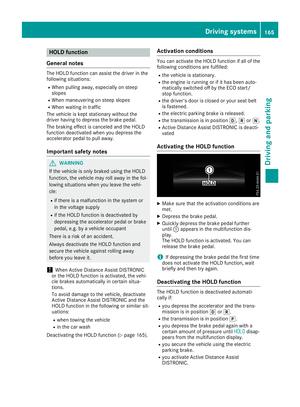 167
167 168
168 169
169 170
170 171
171 172
172 173
173 174
174 175
175 176
176 177
177 178
178 179
179 180
180 181
181 182
182 183
183 184
184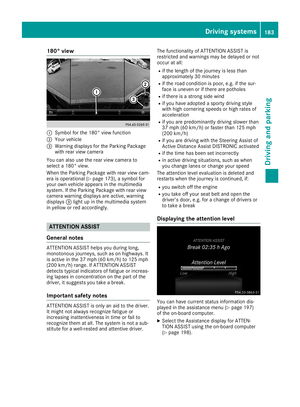 185
185 186
186 187
187 188
188 189
189 190
190 191
191 192
192 193
193 194
194 195
195 196
196 197
197 198
198 199
199 200
200 201
201 202
202 203
203 204
204 205
205 206
206 207
207 208
208 209
209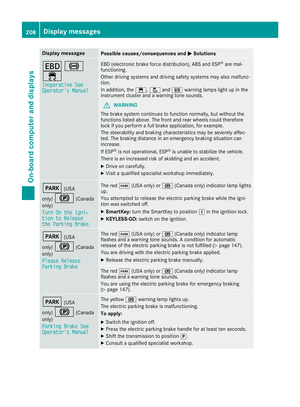 210
210 211
211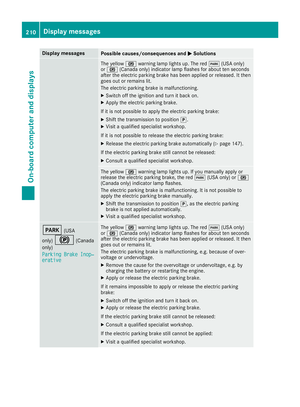 212
212 213
213 214
214 215
215 216
216 217
217 218
218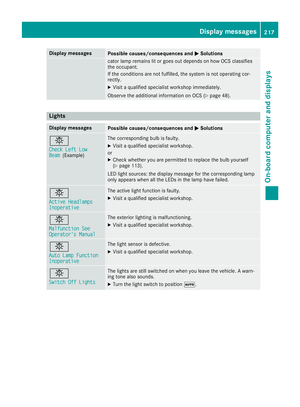 219
219 220
220 221
221 222
222 223
223 224
224 225
225 226
226 227
227 228
228 229
229 230
230 231
231 232
232 233
233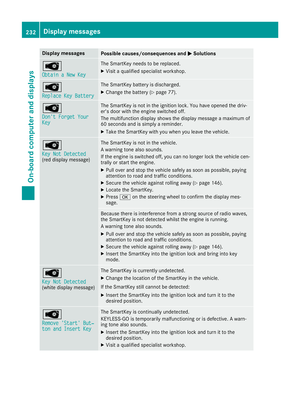 234
234 235
235 236
236 237
237 238
238 239
239 240
240 241
241 242
242 243
243 244
244 245
245 246
246 247
247 248
248 249
249 250
250 251
251 252
252 253
253 254
254 255
255 256
256 257
257 258
258 259
259 260
260 261
261 262
262 263
263 264
264 265
265 266
266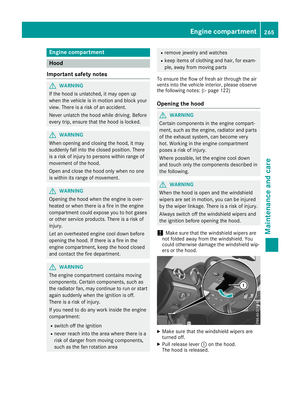 267
267 268
268 269
269 270
270 271
271 272
272 273
273 274
274 275
275 276
276 277
277 278
278 279
279 280
280 281
281 282
282 283
283 284
284 285
285 286
286 287
287 288
288 289
289 290
290 291
291 292
292 293
293 294
294 295
295 296
296 297
297 298
298 299
299 300
300 301
301 302
302 303
303 304
304 305
305 306
306 307
307 308
308 309
309 310
310 311
311 312
312 313
313 314
314 315
315 316
316 317
317 318
318 319
319 320
320 321
321 322
322 323
323 324
324 325
325 326
326 327
327 328
328 329
329






